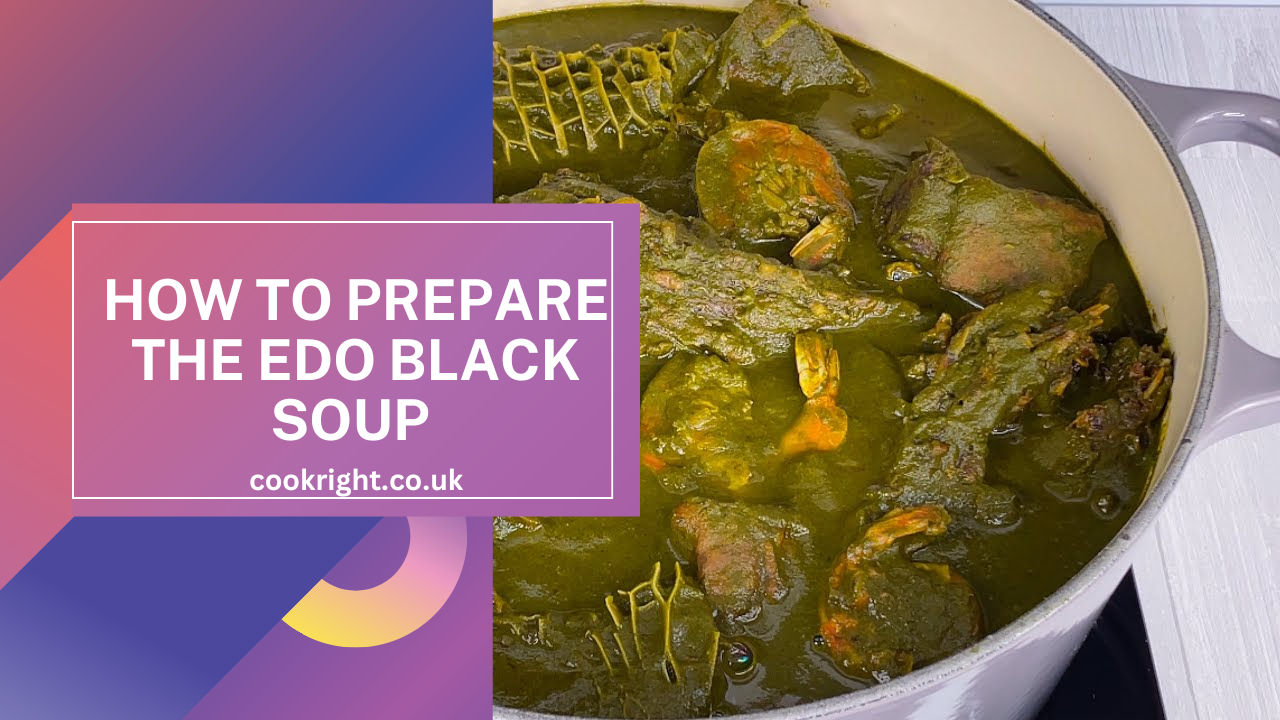Black Soup is a traditional delicacy from the Edo and Delta states of Nigeria. Known for its rich, dark color and earthy flavor, this soup is a favorite among many Nigerian families. It’s not only delicious but also packed with nutrients, thanks to the unique blend of native spices and vegetables. Whether you’re new to Nigerian cuisine or looking to perfect your Black Soup recipe, this guide will take you through the steps to create a sumptuous pot of Black Soup that will leave your taste buds yearning for more.
Ingredients
To make a traditional Black Soup, you’ll need the following ingredients:
- Bitter leaves (Ofe Onugbu) or Scent leaves (Efirin): These are the key ingredients that give the soup its dark color and distinctive taste. You can also use a combination of both leaves for a more complex flavor.
- Palm fruit extract or Palm oil: This provides the rich, oily base that is characteristic of Nigerian soups.
- Assorted meat (beef, goat meat, and tripe): This adds flavor and protein to the soup. You can use a mix of your preferred meats.
- Dry fish and stockfish: These add a smoky flavor and additional depth to the soup.
- Periwinkles (optional): These are a delicious addition that adds texture and a unique taste.
- Ground crayfish: This enhances the overall flavor of the soup.
- Pepper (fresh or dry): To add some heat; adjust according to your spice tolerance.
- Onions: Used to flavor the stock.
- Seasoning cubes or powder: To enhance the taste.
- Salt: To taste.
Step-by-Step Preparation
Step 1: Preparing the Vegetables
- Wash the Bitter or Scent Leaves: If using bitter leaves, ensure you wash them thoroughly to remove the bitterness. This can be done by squeezing and rinsing the leaves several times with clean water. Scent leaves, on the other hand, do not need as much washing. If using a combination of both, prepare them separately and mix after washing.
- Blend the Leaves: Once the leaves are properly washed, blend them into a smooth paste using a blender. You may need to add a little water to help the blending process. The consistency should be smooth but not too watery.
Step 2: Preparing the Meat and Fish
- Season and Cook the Meat: Wash your assorted meats thoroughly. In a pot, season the meat with salt, chopped onions, and seasoning cubes. Add a little water and let it cook until tender. This process might take about 30-45 minutes, depending on the type and size of the meat.
- Prepare the Dry Fish and Stockfish: While the meat is cooking, soak the stockfish in hot water for about 15 minutes to soften it, then rinse thoroughly. Break the dry fish into pieces and ensure it is free from sand and bones.
- Add Fish to the Meat: Once the meat is tender, add the dry fish and stockfish to the pot. Allow them to cook together for about 10 minutes. This allows the flavors to meld.
Step 3: Making the Palm Fruit Extract (Banga) Base
- Boil and Extract Palm Fruit Juice: If using fresh palm fruits, boil them until soft, then pound in a mortar to extract the juice. If you prefer a shortcut, you can use canned palm fruit extract. Pour the juice into the pot with the meat and fish, ensuring the consistency is not too thick or watery.
- Cook the Palm Extract: Allow the extract to boil for about 10 minutes. This helps to reduce the oil’s thickness and blends the flavors with the meat and fish.
Step 4: Adding the Vegetables and Final Ingredients
- Add the Blended Leaves: Stir in the blended bitter or scent leaves into the pot. Mix thoroughly and allow the soup to cook for about 10-15 minutes. You’ll notice the soup getting darker as it cooks, which is a sign that the vegetables are releasing their color.
- Season the Soup: Add ground crayfish, pepper, and any additional seasoning cubes to taste. Adjust the salt if necessary.
- Incorporate Periwinkles (Optional): If you’re using periwinkles, add them at this stage and allow the soup to simmer for an additional 5 minutes. This allows the periwinkles to absorb the flavors of the soup.
- Final Adjustments: Taste the soup and make any final adjustments to the seasoning. If it’s too thick, you can add a little water to reach your desired consistency. The soup should be richly flavored with a harmonious balance of the bitter and scent leaves.
Serving Suggestions
Black Soup is best enjoyed with a variety of Nigerian swallow options such as:
- Pounded Yam: This is the most popular option, providing a smooth, slightly sweet accompaniment to the earthy soup.
- Eba (Garri): Made from cassava flour, Eba is a common choice that pairs well with the rich soup.
- Semo or Wheat: These are healthier alternatives if you’re looking to cut down on carbohydrates.
- Fufu: Whether made from plantain, cassava, or cocoyam, Fufu offers a softer, more pliable option for scooping up the delicious soup.
Nutritional Benefits
Black Soup is not just delicious; it’s also packed with nutrients. Bitter leaves are known for their medicinal properties, including aiding digestion and reducing blood sugar levels. Scent leaves are rich in vitamins A, C, and K and provide antioxidants that help boost the immune system. The assorted meats provide protein, while the palm fruit extract adds healthy fats essential for energy.
Tips and Tricks
- Adjust the Bitterness: If the soup is too bitter for your taste, you can use more scent leaves or add a pinch of sugar to balance it out.
- Blend Thoroughly: Ensure that the vegetables are well blended to achieve a smooth, uniform consistency in the soup.
- Slow Cooking: Allow the soup to simmer gently to let all the flavors meld together beautifully. Rushing the process can result in a soup that lacks depth.
- Spice Levels: Adjust the pepper to suit your preference. You can make it as mild or as spicy as you like.
Conclusion
Black Soup is a flavorful and nutritious dish that is deeply rooted in Nigerian culinary traditions. It is perfect for family gatherings, special occasions, or simply as a comforting meal on a cold day. By following these steps, you can create a delicious pot of Black Soup that celebrates the rich heritage of Nigerian cuisine. So gather your ingredients, follow the guide, and enjoy the delightful experience of making and tasting this wonderful soup!




